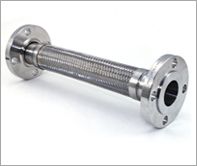Theoretical comparisons between steel grades only tell part of the story. Real applications reveal how these materials behave under actual operating conditions. Engineers face different challenges depending on whether components see extreme heat or require structural strength at lower temperatures.
High-Temperature Applications
- Thermal Exposure Requirements: Equipment operating above 1800°F needs austenitic grades that maintain stability. 310 stainless steel pipe resists oxidation and scaling in furnace systems, exhaust manifolds, and heat treatment equipment. The high chromium and nickel content creates a protective oxide layer that regenerates during service.
- Expansion and Joint Design: Heating causes significant dimensional changes. A 20-foot section of 310 tubing can expand over an inch at operating temperature. Designers must account for this movement through expansion loops, flexible couplings, or sliding supports. Fixed restraints will crack welds or buckle the pipe.
Structural and Moderate-Temperature Zones
- Mechanical Strength Priorities: Shafts, fasteners, and load-bearing frames need hardness over heat resistance. 410 stainless steel tube provides tensile strength exceeding 115 ksi after heat treatment. This martensitic grade machines well and accepts surface hardening for wear resistance in conveyor rollers, valve stems, and structural bracing.
- Corrosion Considerations: The 410 grade offers moderate corrosion resistance in dry or mildly corrosive environments. Water treatment plants and food processing facilities use it for components that don’t contact aggressive chemicals. Marine applications require protective coatings since chloride exposure causes pitting.
Design Parameters for Tube Selection
- Wall Thickness Calculations: Pressure rating formulas account for temperature derating. A schedule 40 pipe adequate at 400°F may fail at 1500°F as allowable stress drops. The following factors determine minimum wall thickness:
- Operating pressure and temperature combined effects
- Corrosion allowance for expected service life
- Weld joint efficiency if seamed tubing is specified
- Code requirements from ASME B31.3 or equivalent standards
- Material Compatibility Issues: Mixing dissimilar metals creates galvanic cells. Carbon steel flanges bolted to 310 stainless piping accelerate corrosion at the junction. Isolating gaskets or using matching bolt materials prevents electrochemical degradation. Temperature cycling makes these effects worse.
Assembly and Installation Guidelines
- Welding Procedures: Each grade demands different filler metals and heat input. The 310 grade uses ER310 filler wire with controlled interpass temperature below 350°F. Fast cooling rates in 410 create hard, brittle zones unless preheat reaches 400°F and post-weld heat treatment follows.
- Support Spacing: Thermal movement and dead weight determine hanger locations. Austenitic tubes need closer support spacing than carbon steel due to lower elastic modulus. A 4-inch diameter 310 line requires supports every 12 feet versus 15 feet for equivalent carbon steel.
- Procurement Verification: Mill test reports confirm chemical composition and mechanical properties meet specification requirements. Check heat numbers match physical material markings. Verify hardness testing results for 410 material to ensure proper heat treatment occurred before installation.
Matching tube grade to operating conditions prevents premature failures and costly replacements. High-temperature oxidation demands 310 material properties. Structural applications benefit from 410 hardness and machinability. Review design loads, environmental exposure, and thermal cycles before specifying either grade. Contact qualified metallurgists or consult ASTM standards for specific applications requiring detailed material certification.
Featured Image Source: https://media.gettyimages.com/id/157429521/photo/metal-pipes.jpg?s=612×612&w=0&k=20&c=9_WZm5NmTzj70m46yZmSv4ppJAGEaLFuybPJREBmKGc=





